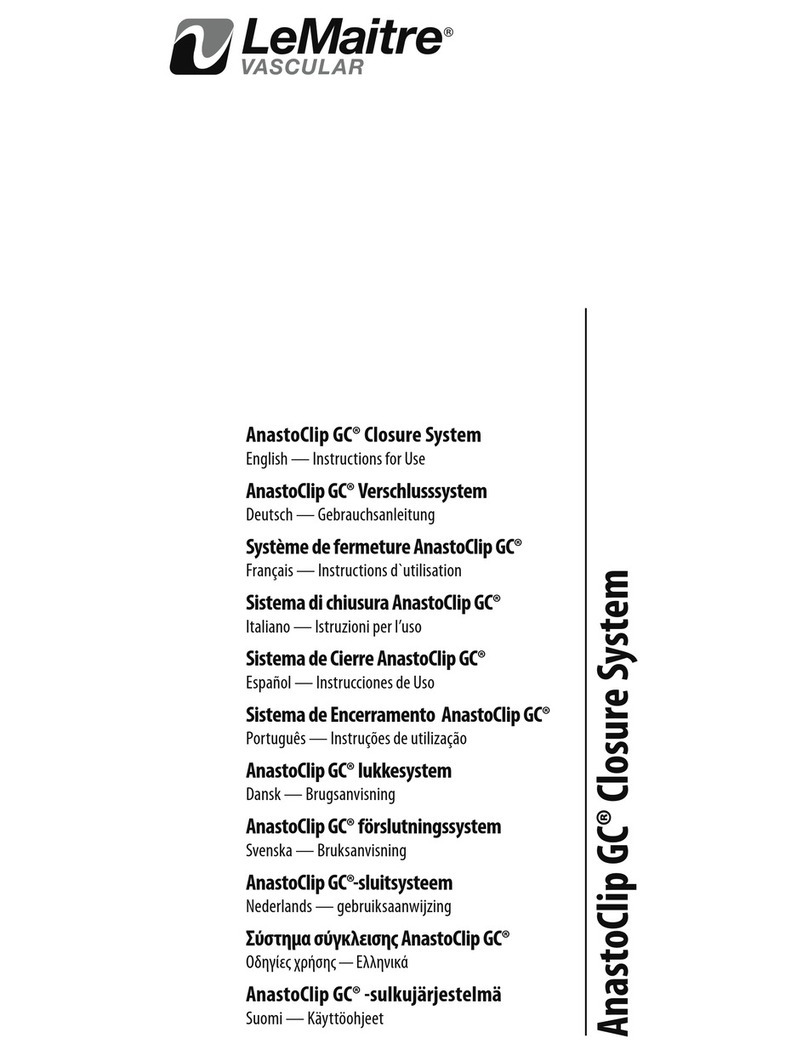
3
talking to your provider rst.
Intended Performance
• Patient monitoring is essential when the graft is used for vascular access to prevent excessive damage from complications.
• This is your graft and part of your body. If there is any evidence of bulge, redness, tenderness, or skin changes, immediately tell your provider.
Long-term Protection Measures for Your Graft
• Avoid prolonged extreme extension of the arm or leg with the implantation as it could lead to nerve damage.
• Avoid extreme or abrupt movements of the arm, shoulder, or legs during a post-operative period of 1.5 to 2 months. Specically, you should not reach out
in front, raise arms above shoulder level, throw, pull, stride, or twist.
• Avoid sleeping on the graft implantation side of your body or crossing your legs for prolonged periods as it may cause compression.
Electrical and Magnetic Sensitivity
• The device is not aected by electrical, magnetic or electro-magnetic interference. No precautions need to be taken when in the vicinity of these devices.
• There is no interaction of the graft with metal detectors and devices used at airport security checks.
Post-surgical Monitoring
• Check your incision and the rest of the implant extremity (arm or leg) every day. Pay attention to how you feel.
• Call your provider immediately if you have any signs of a blood clot, swelling, unusual skin color or infection such as:
1. Increased pain
2. Swelling, redness, or red streaks
3. Blood or pus draining from the incisions
4. Numbness
5. Fever
• Check for signs of good circulation. Your foot or leg should not be cool, pale, experience pain, change colors, have sudden bulging around the access site, or
have other symptoms similar to pre-surgery. Call your provider if you are experiencing any of these symptoms.
• Check for signs of good circulation. It is a problem if your hand or arm is cool or pale, if it changes color, or if you have sudden bulging around your access.
• Call your provider immediately if bleeding from your access site persists.
• The nature and frequency of regular or preventive examination, monitoring or maintenance will be determined by your provider. This will be based on
your underlying medical condition and the status of your graft.
Additional Post-surgical Monitoring for Hemodialysis
Check your access site for a pulse or“thrill”vibration. To feel it, place your rst two ngers over the graft, or listen with a stethoscope. If you are able to listen
with a stethoscope, you should be able to hear a repetitive whooshing sound. If you do not hear it or feel a pulse, the graft may be malfunctioning. Contact
your provider with any concerns.
Lifetime of the Device
• The lifetime of the device has been shown to be safe and eective up to 6.5 years on average. Proper care and regular medical follow up may extend the
life of the device.
• To ensure your graft functions as intended, follow the guidance of your health care provider.
When to Contact Your Provider
Closely watch for any changes in your health. Seek emergency care anytime you experience:
• Lost consciousness
• Trouble breathing
• Extremity has severe pain or becomes cold, pale, blue, tingly, or numb.
• Pain that does not get better after you take pain medicine.
• Loose stitches, or your incision opens.
• Extensive bleeding from the incision.
• Signs of infection, such as:
1. Increased pain, swelling, warmth, or redness.
2. Red streaks leading from the incision.
3. Pus draining from the incision.
4. A fever over 101°F (38.3°C).
5. You are nauseous or cannot keep uids down.
• You have chest pain, dizziness, problems thinking clearly, or shortness of breath that does not go away when you rest
• You are coughing up blood or yellow or green mucus
• You have chills

























